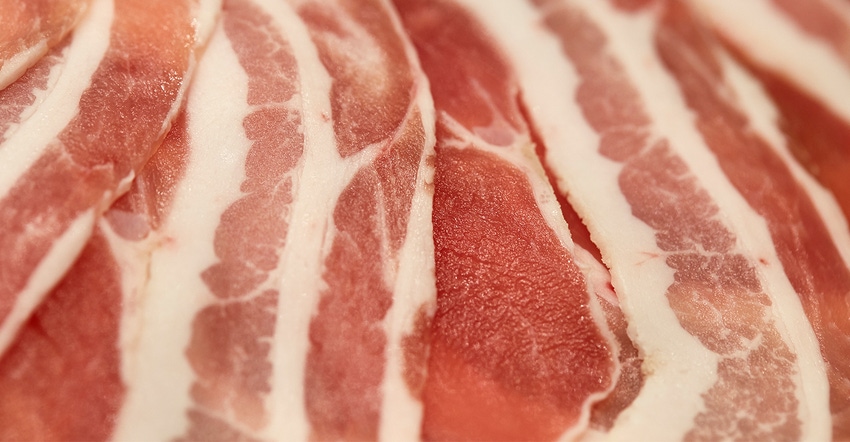
Consumers may have a way to extend the shelf life of bacon, and they don’t need a magic container or special plastic bag to do the trick. University of Missouri meat scientist Bryon Wiegand is researching how high-oleic soybean oil can improve a pig’s fat profile when used in swine rations.
Wiegand has been conducting fat quality research for 25 years and has seen a reoccurring problem with bacon. If it sits for a long period of time it can develop an off flavor. Wiegand says the fat in the meat deteriorates over time, a process called oxidation, which is when oxygen interacts with the meat product. To avoid this, there needs to be a way to stabilize the fat in bacon. To accomplish that, farmers may need to change what they are feeding to hogs.
Soybean meal is not equal
For decades, soybean meal has been used as an animal feed. "It is a high-quality protein that fits into animal diets nicely," Wiegand says.
Traditional soybean oil, what farmers have been feeding livestock for last decades, has a lot of linoleic acids which are predominately fatty acid.
"It is made up of 18 carbons and two double bonds, which makes it a poly unsaturated fat," Wiegand explains. "That is why it is an oil and not solid."
Wiegand says the oil is great for human consumption because cardiologists like more unsaturated fat in American’s diet. The problem in feeding it to pigs is that unsaturated fats are more subject to oxidation, rancidity and spoilage in general, he says.
A new meal product
High-oleic soybeans are finding their way in the seed world. Just this year, the Missouri Soybean Merchandising Council entered into an agreement with Iowa-based Schillinger Genetics to bring non-GMO high-oleic soybean technology to growers. The new varieties came from research done by University of Missouri plant breeders.
High-oleic soybean oil has 18 carbons and only one double bond. "Only one bond makes less subject to oxidation," Weigand says. "It makes it more stable." That is part of the reason the oil is making its way into the food industry for frying applications — it doesn’t break down easily and consumers can avoid trans fats.
However, Wiegand is most excited about the opportunity high-oleic soybean meal and oil has in the animal world.
Livestock trials underway
How high-oleic oil responds when fed to livestock varies. Wiegand says the difference comes when feeding it to ruminant versus non-ruminant animals.
His department has already conducted trials with feeder lambs and steers — ruminant animals. "I knew with my nutrition background, the rumen will wreck what we put into it," he says. And he was right.
"The rumen attacks the oleic and alters it," he says. "Some of it gets out and does not make it to the fat profile." Simply, it does not justify putting expensive oleic into these animals unless Wiegand can find a way to protect the oleic as it goes into the rumen and back out.
Where Weigand thinks high oleic can help the fat profile is in non-ruminant animals like chickens and hogs.
The University of Missouri conducted a pilot study, feeding high-oleic soybean meal to broiler chickens. "It goes right to the fat profile and changes it," he says. The fat is deposited in the visceral fat of the broiler chicken, which is in the fat pad. However, Americans eat a lot of skinless chicken breasts, so it appears the benefits may be lost. Not so, says Wiegand.
"We feed a ton of poultry fat in this country," he explains. "I can get rendered poultry fat and know it contains high-oleic properties and feed it to the pig then the benefit transfers."
Wiegand started a large-scale broiler high-oleic soybean meal feed trial in September. There he will identity preserve the high-oleic fat, render it and feed it back to pigs. It will tell if vertically coordinated feeding of high-oleic soybeans will pull through for the fat profile from soybean to chicken to pig to bacon.
Directly feeding high-oleic soybeans to a pig will likely change its fat profile as well, but Wiegand says more trials are needed.
Consumers are eating a lot of bacon. "What we need is for that bacon to have a longer shelf life," Wiegand says. Changing up a pig’s diet by feeding high-oleic soybean meal and oil may be just what the meat scientist orders.
About the Author(s)
You May Also Like






